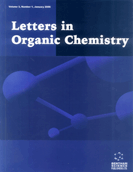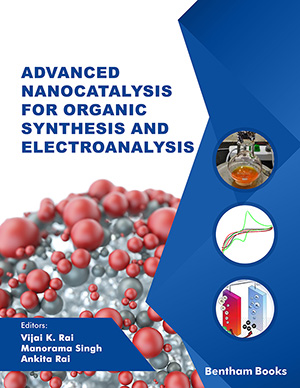Abstract
This comprehensive review explores the advancements in catalytic transformation, focusing on the use of heterogeneous catalytic systems with a particular emphasis on polymeric-supported palladium (Pd) complexes. This study explores the limitations associated with conventional homogeneous reagents, emphasizes the transition to ecofriendly catalytic systems, and emphasizes the importance of Pd nanoparticles. These nanoparticles are particularly noteworthy for their distinctive properties, including elevated catalytic activity, making them promising for various applications in organic synthesis. The review thoroughly examines the design and synthesis of heterogeneous catalysts, emphasizing the crucial selection of safe and recyclable supports to augment the longevity and reusability of metallic catalysts. Diverse polymer varieties, including polystyrene (PS), polyethylene (PE), polyacrylate derivatives, polyethylene glycol (PEG), and grafted polymers, are investigated as viable supports for Pd complexes. The authors intricately describe the synthesis techniques for these polymer- supported Pd catalysts and furnish illustrative examples showcasing their effectiveness in organic transformation. This comprehensive review additionally highlights the synthesis of polymer-supported palladium (Pd) materials and discusses their applications in electrochemistry. The focus extends to the electrocatalytic properties of Pd-based polymeric nanomaterials, showcasing their effectiveness in glucose sensing, hydrogen peroxide detection, and the sensing of other biological analytes. Furthermore, the catalytic capabilities of Pd nanoparticles in various electrochemical applications, including wastewater treatment and electrochemical capacitors, are explored. Integrating polymer-supported Pd materials into these electrochemical processes underscores their versatility and potential contributions to advancements in catalysis and electrochemical sensing. Catalytic applications featuring polymer-supported palladium complexes with polymeric ligands in organic synthesis processes use the Sonogashira reaction, Suzuki-Miyaura coupling, Heck reaction, Catalytic asymmetric transformations, etc. The subsequent section of the paper focuses on the creation of polymeric palladium complexes, achieved by the complexation of polymeric ligands with palladium precursors. It delves into noteworthy examples of catalytic processes employing polymer-supported palladium complexes featuring polymeric ligands, emphasizing distinct polymers, such as PS, PE, polyacrylate derivatives, PEG, and grafting polymers. The review concludes by exploring catalytic asymmetric transformations using chiral palladium complexes immobilized on polymer supports and discusses various chiral ligands and their immobilization on polymer supports, emphasizing their application in asymmetric allylic alkylation. The review furnishes a comprehensive summary of recent advancements, challenges, and prospective avenues in catalytic oxidation facilitated by polymer-supported palladium catalysts with electrochemical applications.
Keywords: Polymer-supported palladium complexes, heterogeneous catalysis, catalytic asymmetric transformation, electrochemical applications, homogeneous reagents, eco-friendly catalytic system.
[http://dx.doi.org/10.1016/B978-0-12-639380-4.50018-X]
[http://dx.doi.org/10.1016/j.molcata.2016.07.047]
[http://dx.doi.org/10.3906/kim-1110-4]
[http://dx.doi.org/10.1016/S0920-5861(97)00024-2]
[http://dx.doi.org/10.1016/j.catcom.2008.03.040]
[http://dx.doi.org/10.1016/j.ccr.2009.03.019]
[http://dx.doi.org/10.1002/anie.200300630] [PMID: 15221827]
[http://dx.doi.org/10.1016/S0040-4020(03)00866-4]
[http://dx.doi.org/10.1016/j.ccr.2007.09.005]
[http://dx.doi.org/10.1016/j.tet.2008.02.098]
[http://dx.doi.org/10.1039/C5GC02264A]
[http://dx.doi.org/10.1016/j.jcis.2017.02.064] [PMID: 28260673]
[http://dx.doi.org/10.1016/j.rser.2019.03.062]
[http://dx.doi.org/10.1007/s10098-015-0914-0]
[http://dx.doi.org/10.1039/C4GC00748D]
[http://dx.doi.org/10.1002/tcr.201700100] [PMID: 29537731]
[http://dx.doi.org/10.1002/chem.201500122] [PMID: 25754469]
[http://dx.doi.org/10.1039/B817669H] [PMID: 19081941]
[http://dx.doi.org/10.1039/C4GC00558A]
[http://dx.doi.org/10.1039/b817112b]
[http://dx.doi.org/10.1016/j.cattod.2017.06.009] [PMID: 31595104]
[http://dx.doi.org/10.1016/j.seppur.2017.05.003]
[http://dx.doi.org/10.1016/j.tet.2017.04.016]
[http://dx.doi.org/10.1016/j.cherd.2017.03.026]
[http://dx.doi.org/10.1016/j.jcis.2016.02.024] [PMID: 26890384]
[http://dx.doi.org/10.1016/j.jtice.2017.12.017]
[http://dx.doi.org/10.1039/c0nr00276c] [PMID: 20694209]
[http://dx.doi.org/10.1039/C5RA26304B]
[http://dx.doi.org/10.1021/cr9003242] [PMID: 20143876]
[http://dx.doi.org/10.1021/cr1002112] [PMID: 21087012]
[http://dx.doi.org/10.1021/acs.chemrev.7b00443] [PMID: 29460627]
[http://dx.doi.org/10.1016/j.cattod.2019.03.023]
[http://dx.doi.org/10.1002/adsc.201800343]
[http://dx.doi.org/10.1016/0378-4274(79)90113-9]
[http://dx.doi.org/10.1039/C5MT00249D] [PMID: 26739318]
[http://dx.doi.org/10.1021/jo050721m] [PMID: 16095291]
[http://dx.doi.org/10.1039/C8GC01240G]
[http://dx.doi.org/10.1016/j.tet.2009.11.050]
[http://dx.doi.org/10.1016/j.molcata.2010.08.023]
[http://dx.doi.org/10.1016/j.jcat.2016.05.015]
[http://dx.doi.org/10.1016/j.mcat.2018.07.007]
[http://dx.doi.org/10.1055/s-1997-1358]
[http://dx.doi.org/10.1055/s-2000-6310]
[http://dx.doi.org/10.1021/cr00042a001]
[http://dx.doi.org/10.1002/3527601856]
[http://dx.doi.org/10.1039/b006588i]
[http://dx.doi.org/10.1002/3527603034]
[http://dx.doi.org/10.1021/cr0103571] [PMID: 12371885]
[http://dx.doi.org/10.1021/jo00886a023]
[http://dx.doi.org/10.1016/0021-9517(76)90378-X]
[http://dx.doi.org/10.1021/ja00492a084]
[http://dx.doi.org/10.1002/anie.197504932]
[http://dx.doi.org/10.1039/c39860000949]
[http://dx.doi.org/10.1246/cl.1975.1005]
[http://dx.doi.org/10.1016/S0022-328X(00)81408-4]
[http://dx.doi.org/10.1021/jo00324a029]
[http://dx.doi.org/10.1021/jo00350a076]
[http://dx.doi.org/10.1021/jo00375a002]
[http://dx.doi.org/10.1021/ja00235a027]
[http://dx.doi.org/10.1021/jo00272a050]
[http://dx.doi.org/10.1021/om020352+]
[http://dx.doi.org/10.1021/cr010343v] [PMID: 12371888]
[http://dx.doi.org/10.1016/S0040-4039(97)10130-7]
[http://dx.doi.org/10.1021/ja001708g]
[http://dx.doi.org/10.1021/cr960064l] [PMID: 11848880]
[http://dx.doi.org/10.2174/1385272023373671]
[http://dx.doi.org/10.1021/cc000046o] [PMID: 11126287]
[http://dx.doi.org/10.1021/ar990140h] [PMID: 10955985]
[http://dx.doi.org/10.1039/a901955c]
[http://dx.doi.org/10.1021/cr010335e] [PMID: 12371887]
[http://dx.doi.org/10.1021/ja991099g]
[http://dx.doi.org/10.1002/1521-3773(20011015)40:20<3750:AID-ANIE3750>3.0.CO;2-6]
[http://dx.doi.org/10.1021/cr960118r] [PMID: 12744693]
[http://dx.doi.org/10.1039/a608388i]
[http://dx.doi.org/10.1002/chem.200390161] [PMID: 12645031]
[http://dx.doi.org/10.1016/S0040-4039(00)91094-3]
[http://dx.doi.org/10.1021/jo970913k]
[http://dx.doi.org/10.1007/b96874] [PMID: 23900911]
[http://dx.doi.org/10.1016/S0040-4039(97)00702-8]
[http://dx.doi.org/10.1016/S0040-4020(99)00883-2]
[http://dx.doi.org/10.1002/chin.200002081]
[http://dx.doi.org/10.1055/s-2002-35605]
[http://dx.doi.org/10.1021/jo982438b] [PMID: 11674453]
[http://dx.doi.org/10.1021/ol0264298] [PMID: 12182608]
[http://dx.doi.org/10.1039/b106336g]
[http://dx.doi.org/10.1002/anie.199715261]
[http://dx.doi.org/10.1039/b107452k] [PMID: 12120306]
[http://dx.doi.org/10.1016/S0022-328X(98)00684-6]
[http://dx.doi.org/10.1021/om010314a]
[http://dx.doi.org/10.1002/1521-3773(20000818)39:16<2903:AID-ANIE2903>3.0.CO;2-Q] [PMID: 11028004]
[http://dx.doi.org/10.1021/ar00173a007]
[http://dx.doi.org/10.1021/cr0103423] [PMID: 12371886]
[http://dx.doi.org/10.1021/ja991501r]
[http://dx.doi.org/10.1139/v00-018]
[http://dx.doi.org/10.1021/ja003854s] [PMID: 11456979]
[http://dx.doi.org/10.1021/jo000433k] [PMID: 11149826]
[http://dx.doi.org/10.1021/ma020901n]
[http://dx.doi.org/10.1021/ol0340181] [PMID: 12688718]
[http://dx.doi.org/10.1002/9783527613144]
[http://dx.doi.org/10.1016/0957-4166(95)00136-D]
[http://dx.doi.org/10.1016/S0040-4039(98)01812-7]
[http://dx.doi.org/10.1016/S0957-4166(99)00416-4]
[http://dx.doi.org/10.1016/S0957-4166(01)00245-2]
[http://dx.doi.org/10.1021/ol005947k] [PMID: 10891226]
[http://dx.doi.org/10.1002/1521-3773(20021018)41:20<3852:AID-ANIE3852>3.0.CO;2-I] [PMID: 12386868]
[http://dx.doi.org/10.1002/anie.200290018] [PMID: 12481328]
[http://dx.doi.org/10.1021/cr020027w] [PMID: 12914486]
[http://dx.doi.org/10.1016/j.nantod.2011.04.007]
[http://dx.doi.org/10.1016/j.bios.2006.03.008] [PMID: 16644200]
[http://dx.doi.org/10.1021/ac901005p] [PMID: 19715358]
[http://dx.doi.org/10.1007/s00604-013-1098-0]
[http://dx.doi.org/10.1002/elan.201300428]
[http://dx.doi.org/10.1002/adfm.200700729]
[http://dx.doi.org/10.1016/j.aca.2014.04.062] [PMID: 24890692]
[http://dx.doi.org/10.1016/j.snb.2014.01.015]
[http://dx.doi.org/10.1016/j.bios.2008.06.011] [PMID: 18640024]
[http://dx.doi.org/10.1016/j.bios.2013.01.020] [PMID: 23428731]
[http://dx.doi.org/10.1039/c3ay41039k]
[http://dx.doi.org/10.1016/j.snb.2014.11.091]
[http://dx.doi.org/10.1080/25740881.2020.1844233]
[http://dx.doi.org/10.1002/elan.202060129]
[http://dx.doi.org/10.1016/j.electacta.2011.09.064]
[http://dx.doi.org/10.1016/j.molcata.2011.09.004]
[http://dx.doi.org/10.1039/c3nj00138e]
[http://dx.doi.org/10.1016/j.apcatb.2014.07.009]
[http://dx.doi.org/10.1016/j.matchemphys.2014.08.047]
[http://dx.doi.org/10.1016/j.jcis.2012.04.036] [PMID: 22609190]
[http://dx.doi.org/10.1039/c2gc16359d]


























